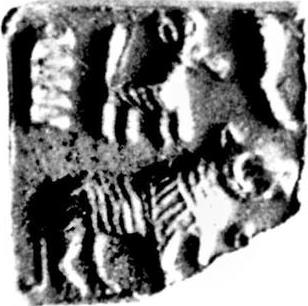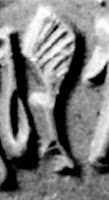Mirror: http://tinyurl.com/paon47k
An excellent example of hieroglyph-writing is a Mohenjo-daro seal with Indus Script. The hieroglyph-multiplex relates to metalwork cataloguing the work of a smelter-guild with a mint, smithy and brazier. The cipher is comparable to the N'r M'r palette rebus-metonymy cipher of Egyptian hieroglyphs signifying cuttle-fish, awl respectively to combine as the syllables in the name of Narmer.
Tiger is a wild animal. To show a feeding-trough in front of the animal on a seal is a clear signifier that both are hieroglyphs and should be read as a cipher.
Tiger is a wild animal. To show a feeding-trough in front of the animal on a seal is a clear signifier that both are hieroglyphs and should be read as a cipher.
Mohenjo-daro Seal m290 deciphered -- metalwork catalogue: hieroglyphs: tiger, trough, thigh, onager, comb; Rebus-metonymy cipher: smelter-guild, mint, smith, brazier. This decipherment is consistent with the entire Indus Script Corpora as catalogus catalogorum of metalwork.
Hieroglyphs: kola 'tiger', pattar 'trough', ṭanka 'thigh', khar 'onager', kanka
Rebus: kol'working in iron'kolhe 'smelter', pattar'smith-guild',ṭanka'mint, coiner', khār 'blacksmith', kanga'brazier'. Thus, the message is: guild of brazier, blacksmith, mint-master, smelter.
See: http://bharatkalyan97.blogspot.in/2015/08/indus-script-hieroglyphs-metalwork.html This monograph is updated.
 Seal m 290 Mohenjo-daro
Seal m 290 Mohenjo-daroHieroglyphs and rebus Meluhha readings:

 Seal m 71 Mohenjo-daro. Hind leg hieroglyph: Pk. ṭaṁka -- m., °kā -- f. ʻ leg ʼ, S. ṭaṅga f., L. P. ṭaṅg f., Ku. ṭã̄g, N. ṭāṅ; Or. ṭāṅka ʻ leg, thigh ʼ, °ku ʻ thigh, buttock ʼ. 2. B. ṭāṅ, ṭeṅri ʻ leg, thigh ʼ; Mth. ṭã̄g, ṭãgri ʻ leg, foot ʼ; Bhoj. ṭāṅ, ṭaṅari ʻ leg ʼ, Aw. lakh. H. ṭã̄g f.; G. ṭã̄g f., °gɔ m. ʻ leg from hip to foot ʼ; M. ṭã̄g f. ʻ leg ʼ(CDIAL 5428) Rebus: stamped coin, mint: टंक (p. 335) [ ṭaṅka ] m S A stone-cutter's chisel. 2 A weight equal to four
Seal m 71 Mohenjo-daro. Hind leg hieroglyph: Pk. ṭaṁka -- m., °kā -- f. ʻ leg ʼ, S. ṭaṅga f., L. P. ṭaṅg f., Ku. ṭã̄g, N. ṭāṅ; Or. ṭāṅka ʻ leg, thigh ʼ, °ku ʻ thigh, buttock ʼ. 2. B. ṭāṅ, ṭeṅri ʻ leg, thigh ʼ; Mth. ṭã̄g, ṭãgri ʻ leg, foot ʼ; Bhoj. ṭāṅ, ṭaṅari ʻ leg ʼ, Aw. lakh. H. ṭã̄g f.; G. ṭã̄g f., °gɔ m. ʻ leg from hip to foot ʼ; M. ṭã̄g f. ʻ leg ʼ(CDIAL 5428) Rebus: stamped coin, mint: टंक (p. 335) [ ṭaṅka ] m S A stone-cutter's chisel. 2 A weight equal to four Hieroglyph: khara1 m. ʻ donkey ʼ KātyŚr., °rī -- f. Pāṇ.NiDoc. Pk. khara -- m., Gy. pal. ḳăr m., kắri f., arm. xari, eur. gr. kher, kfer, rum. xerú, Kt. kur, Pr. korūˊ, Dm. khar m., °ri f., Tir. kh*l r, Paš. lauṛ. khar m., khär f., Kal. urt. khār, Phal. khār m., khári f., K.khar m., khürü f., pog. kash. ḍoḍ. khar, S. kharu m., P. G. M. khar m., OM. khari f.; -- ext. (CDIAL 3818) kharun - khalun transform attested in Kashmiri. So, too khura - khulan 'wild ass' (Skt. -- Mongolian) khaḍ 1 खड् m. an ass, i.q. khar 1. This is the form that the word takes towards Islāmābād (El.). khar 1 खर् खरः m. (f. khürü ; or khariñ खरिञ्), a donkey, an ass (L.V. 88; K.Pr. 26, 73, 14-5, 166, 174, 19, 215, 235, 262; H. iii, 8, 9; v, 7; K. 224); often used ˚ -- , to indicate the commonest, largest, or coarsest of the kind, like 'horse' in our 'horse-radish', 'a horse-laugh', etc.; cf. khar-bādām, bel., and kharkhasun, s.v. Towards Islāmābād the word is pronounced khaḍ (El.). -āhang -आहंग् f. an ass's bray (K.Pr. 235). Rebus: khār 1 खार् । लोहकारः m. (sg. abl. khāra 1 खार; the pl. dat. of this word is khāran 1 खारन्, which is to be distinguished from khāran 2, q.v., s.v.), a blacksmith, an iron worker kō̃da khārüñü, to raise a kiln; met. to raise or make a really good kiln in which only perfect bricks are baked (Śiv. 133; cf. kō̃da khasüñü, p. 384b, l. 28) (Kashmiri)
 Comb कंकवा (p. 123) [ kaṅkavā ] m A sort of comb. See कंगवा. कोंगें (p. 180) [kōṅgēṃ ] n A long sort of honeycomb.Rebus: kanga'portable furnace' Rebus: kangar'large brazier': *kāṅgārikā ʻpoor or small brazierʼ.
Comb कंकवा (p. 123) [ kaṅkavā ] m A sort of comb. See कंगवा. कोंगें (p. 180) [kōṅgēṃ ] n A long sort of honeycomb.Rebus: kanga'portable furnace' Rebus: kangar'large brazier': *kāṅgārikā ʻpoor or small brazierʼ.Hieroglyph: కోలు (p. 0329) [ kōlu ] kōlu. [Tel.] adj. Big, great, huge పెద్ద. కోలుపులి or కోల్పులి a royal tiger. kul 'tiger' (Santali) Pk. kolhuya -- , kulha -- m. ʻ jackal ʼ < *kōḍhu -- ; H. kolhā, °lā m. ʻ jackal ʼ, adj. ʻ crafty ʼ; G. kohlũ, °lũ n. ʻ jackal ʼ, M. kolhā, °lā m. (CDIAL 3615) Rebus: kolhe 'smelter' kol 'working in iron' kolle 'blacksmith'
, n. 1. See பத்தல், 1, 4, 5. 2. Wooden trough for feeding animals; தொட்டி. பன்றிக் கூழ்ப்பத்தரில் (நாலடி, 257). 3. Cocoanut shell or gourd used as a vessel; குடுக்கை. கொடிக்காய்ப்பத்தர் (கல்லா. 40, 3).
a. pātti bathing tub, watering trough or basin, spout, drain; pattal wooden bucket; pattar id., wooden trough for feeding animals. Ka. pāti basin for water round the foot of a tree. Tu. pāti trough or bathing tub, spout, drain. Te. pādi, pādu basin for water round the foot of a tree. (DEDR 4079) pāˊtra n. ʻ drinking vessel, dish ʼ RV., °aka -- n., pātrīˊ- ʻ vessel ʼ Gr̥ŚrS. [√, n. < T. battuḍu. A caste title of goldsmiths; தட்டார் பட்டப்பெயருள் ஒன்று.
, n. perh. vartaka. Merchants; வியாபாரிகள். (W .)
S. Kalyanaraman
Sarasvati Research Center
September 17, 2015
